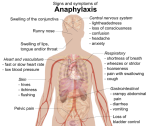In medicine it’s all too easy to assume that a certain symptom is representative of a specific diagnosis. Since allergic symptoms are so common, this is a pitfall we need to be wary of. There’s an old adage, “All that wheezes isn’t asthma.” I’ll add to that “all that sneezes isn’t allergic rhinitis.” Often the only way to establish a definitive diagnosis is through diagnostic testing.
A patient’s history is, of course, the foundation of a correct diagnosis for any medical condition. However diagnostic testing, when available, is invaluable in either supporting a presumptive diagnosis or showing us where we’ve been misled. It’s generally believed that 80% of asthma is extrinsic (allergic) in nature, so one cannot fault a clinician for assuming asthma is due to inflammatory bronchoconstriction, and that an inhaled steroid plus a beta-agonist inhaler should be an effective treatment. But that assumption may be incorrect and the treatment regimen ineffective. I would strongly suggest obtaining a pulmonary function test (PFT) in these patients. A PFT can differentiate between an obstruction due to temporary airway constriction, which may be quickly reversible, and a restriction, which indicates that the fundamental problem is not asthma but another airway disease.
Chapter 8 of my book, Dr. Dean Mitchell’s Allergy and Asthma Solution (Marlowe 2006), addresses “Diseases that Masquerade as Asthma and Allergies.” The following case is typical of those in the book… The patient was a 60-year-old black African American female. She had been experiencing “a whistle in her chest” for about two months. She had coughing episodes and sometimes wiped a couple of drops of blood from her mouth. Her son, a patient of mine, insisted his mom come to see me to be tested for allergies. I knew her son had a lot of allergies however I found it strange that she had no history of allergies or asthma until her seventh decade. Late-onset asthma always alerts me to look for an underlying cause. I tested her for allergies which revealed positives for ragweed and dust mites, similar to her son — but I was still uneasy. I ran a PFT, which revealed a low FEV1 of 70%. While this result could be consistent with the diagnosis of asthma, she also had a low FVC, indicating some restriction. So I ordered a chest-X ray which demonstrated some fluid in the left lower lung field. I reviewed these findings with the radiologist and he recommended a CT scan. The findings on the CT scan unfortunately indicated an endobronchial adenocarcinoma which was blocking her airway and causing the wheezing. In my 22-years in practice, this was the only such case, but it was unforgettable.
Another case I’ll never forget involved a patient with chronic rhinitis. This case was not a patient of mine, but the story was delivered by a staffer who shared office space with me. The staffer’s father had chronic nasal congestion and was “addicted” to Afrin. He couldn’t go a day without it, yet he didn’t feel it was necessary to seek care from a physician. In his late 50s he developed heart problems and the doctors determined that he needed coronary bypass surgery. At age 61, he developed acute shortness of breath. An emergency room chest-X ray revealed bilateral pleural fluid. The cause of the fluid was renal failure—his BUN was over 100! Evaluation of his kidney disease led to the diagnosis of Wegener’s Granulomatosis; a condition of vasculitis in which the immune system attacks the blood vessels. Interestingly, Wegener’s patients typically have chronic rhinitis or sinusitis as the initial presentation. If you have a rhinitis patient that has negative allergy skin testing, and the cause is unclear, a simple Erythrocyte Sedimentation Rate (ESR) (or “sed rate”) to identify an underlying inflammatory process can be a valuable clue to a more serious condition.
I like to teach medical students that when “you hear hoof beats, you don’t usually think of zebras.” In real world practice there are a lot more horses. But keep those striped animals in mind because every so often one will gallop your way, and your ability to recognize it can make all the difference in your patient’s life.
– Dr. Dean Mitchell

